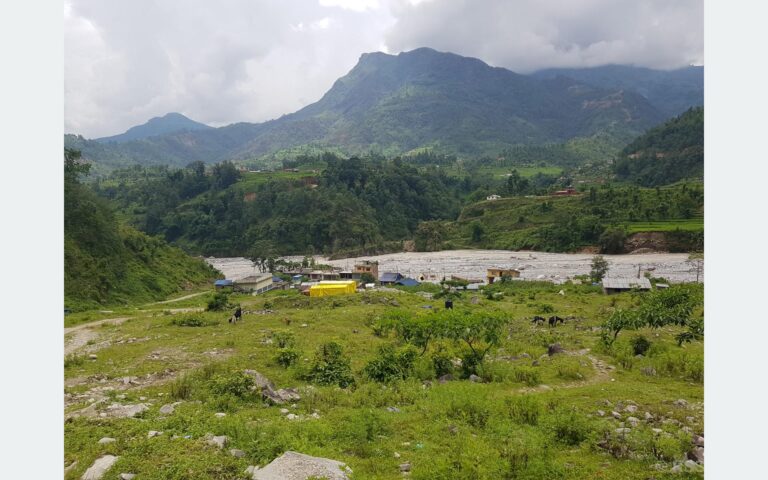
Locals of Helambu in Sindhupalchok district had never thought they would become homeless. Their thinking all went wrong after flood in Melamchi rivulet not only swept away their houses, but also turned their farmland into barren land.
Now they do not want to remember June 15, the day they lost their houses and farmland.
Ramri Lama of Ganeshbagar of Helambu-2, who has become helpless after flood swept away her house and farm, breaks down whenever she recalls the devastation that fateful day.
Her family became landless within few hours after the flood in Melamchi rivulet on June 15 evening swept her house and turned her farm into barren land.
“I was preparing food after returning home from the farm in the evening. Melamchi river flooded all of sudden with a sound like a bomb blast. It was like an earthquake.
The land started shaking. I asked by husband to run away taking citizenship certificate and land ownership certificate.
The Melamchi rivulet had already taken a violent form soon after we reached at a higher land. Our settlement turned into a stretch of debris within a few minutes before our eyes,” Lama said recalling the incident. “We could not take out any goods from our house. The flood also swept away my buffalo inside the cattle shed.”
The locals of the area, ready to harvest the summer paddy and planting the monsoon paddy are now worried about the possible hunger after the flood washed away their rice fields. Sixteen families of Ganeshbagar, who have become homeless, have been kept at higher ground in a tent with the support of the rural municipality and other organisations.
Although the flood has not heavily damaged their houses, 24 other families have also been staying there in tent due to fear of possible damages.
The flood victims said that there is also a risk of coronavirus infection as most of the people staying in tent have now been suffering from fever, cold and cough. A local Kewang Lama says, “We requested the rural municipality for PCR test, but in vain.” Other problems have also been seen as around 150 people are staying at the same place.
He is very sad and dejected seeing the Melamchi rivulet that used to flow at a distance of around half an hour walk from his house has now started flowing close to his house. “Where should we stay?” he questioned.
The rural municipality says it would help construct house if they made arrangement for land plot for the same. Kewang shares, “We have no land at other place.
If we construct house in the previous place, such type of flood might take place again. The government should construct houses for us at the highland area of Ganeshbagar.”
They had also asked the then Prime Minister KP Sharma Oli for the same during his inspection of flood-hit areas few days ago, he added. Kewang had constructed an RCC house there purchasing four ana of land at a cost of Rs 400,000 after the Gorkha earthquake damaged his house located at Ghyangphedi of the district.
A local Kewang Lama is also suffering from the same fate. “A house of neighbor fell upon my house and my house has been completely damaged due to this. The Melamchi river has now started flowing nearby my house.”
“I constructed a house taking loan after the earthquake, but again we became homeless. Nature also becomes cruel to poor people,” he said with tears in his eyes.
Sixteen people of Helambu lost their lives untimely in this year’s flood. Most of the houses of Chanaute, the main business hub of this area, have been damaged by flood. More than 350 hectares of fertile land has turned into a barren land.
The flood affected people are in tension due to uncertainty about their stay in tent in lack of concrete efforts from any concerned body for their rehabilitation even one month since the flood. They become anxious after the sky starts becoming cloudy thinking another mishap might take place again.
This year’s flood has become an incident of incomparable loss to the coming generation of the locals. Locals of Sindhupalchok district have been suffering from all types of natural disasters time and again.
Locals said that the flood has caused massive destruction in the downstream side as the flood also swept away the huge quantity of mud thrown haphazardly in course of constructing Melamchi Drinking Water Project.
A local social worker, Hasta Pandit, shared that project’s apathy for proper management of the large quantity of earth extracted when constructing the project structures on time is one of the reasons behind the huge loss of lives and property.
Pandit argued that a high-level study is necessary regarding management of the Melamchi rivulet on time as there is a possibility of its entering the market and settlement areas.
Surface of rivulet has increased up to 15-25 feet higher due to this flood and there is possibility of entering the minor flood in the settlement and market area in days to come. He also pointed out the need of high-level study regarding changes in the geomorphology in the mountainous areas.
Locals of flood-hit Melamchi bazaar have now started taking out goods from the wreckage of their damaged houses as well as removing mud, sand and stones deposited by the flooding.
No human casualties were reported at Melamchi bazaar as the locals got the early warning about flood in the rivulet – only some while before tha catastrophe. Only few locals were able to take out important documents and valuable goods from their houses.
Ward Chairperson of Melamchi-6, Jitraj Thapa said that the incident has taught a lesson that the pre-information during natural disaster could help prevent huge losses. Constructing houses and other physical infrastructures and cultivating by encroaching the land near the rivulet are among the reasons behind this huge destruction, he added.
He opined, “Out of the damaged infrastructures including houses, suspension bridges and RCC bridges, 90 per cent were built against the building code. Though there is a provision of not constructing the houses and other structures up to 100 metres area from the bank of a river, most of them had not left even 25 meters.”
Activities are now underway to make the rivulet deeper extracting the stones using excavator at flood hit areas. Thapa further said, “The Melamchi municipality has set up a fund of Rs 5 million initially.
So far around Rs 60 million has been deposited in the fund with the support of different bodies. A plan has been made for the rehabilitation of the flood survivo rsand reconstruction of the damaged infrastructures from the fund.”
Deputy Mayor of Melamchi municipality, Bhagawati Nepal, shared that though the district is at high risk in view of natural disaster, they had not imagined such scale of violent flood would ever occur.
She clarified that although victims were rescued and they have been rehabilitated with the help of locals and security personnel soon after the flood, losses could not be reduced in lack of awareness among the community regarding disaster preparedness.
She argued, “No complaints were received as the relief materials provided by different bodies and individuals soon after the disaster were distributed through one-door policy.”
Nepal, however, said that problems were encountered in the rescue, relief and rehabilitation works in lack of awareness regarding humanitarian sensitivity during disaster.
The Basic Humanitarian Criteria prepared by the National Disaster Risk Reduction Centre under the Asian Preparedness Partnership Programme run with the support of Asian Disaster Preparedness Centre has laid emphasis on nine different commitments to improve quality and effectiveness of humanitarian response by organisations and individuals in order to save from and reduce the humanitarian pain during disaster.
It will be proved that all the three tiers of the government, NGOs, and other bodies concerned are more responsible if the support would be made more effective and systematic as per the criteria by keeping the human rights and humanitarian norms of victims in mind during disaster hour.
Source : RSS,





